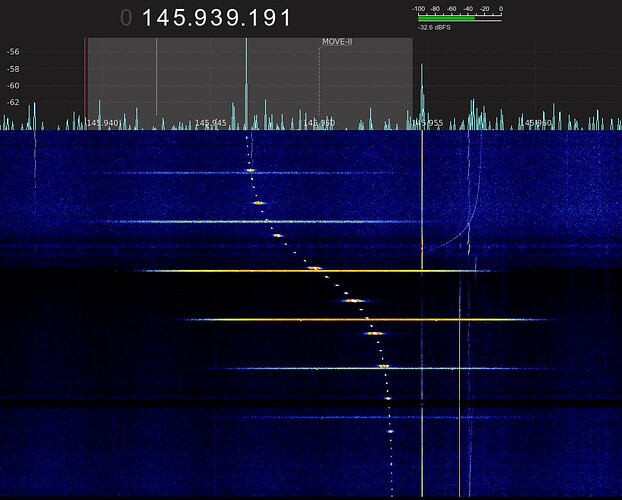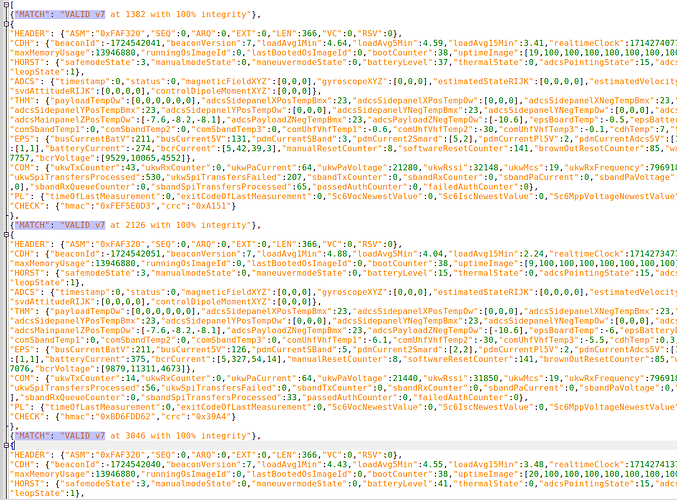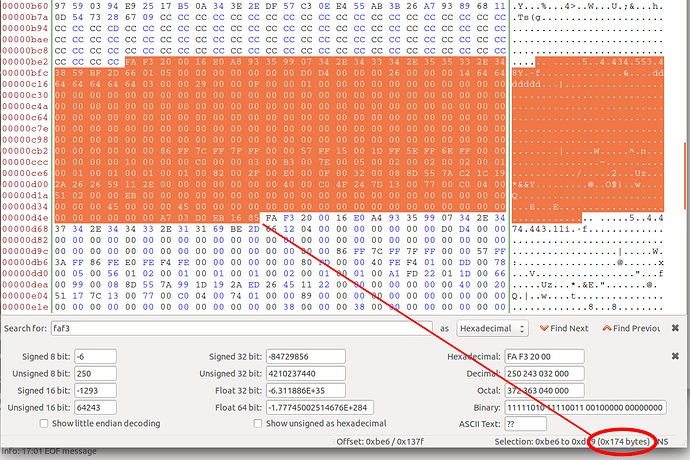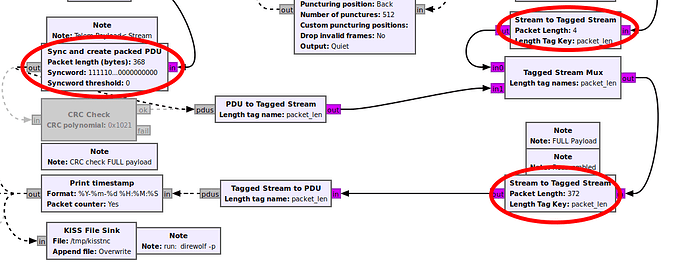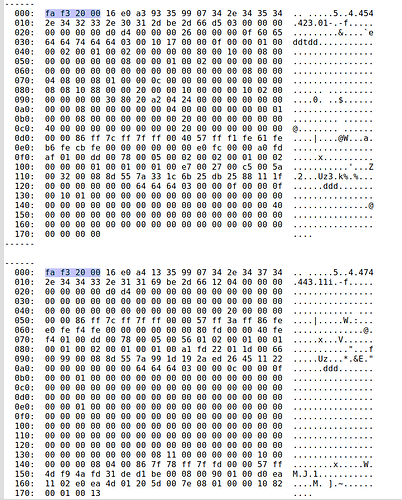[
{“MATCH”: “BROKEN v7 at 4187 with 100% integrity”},
{
“HEADER”: {“ASM”:“0xFAF320”,“SEQ”:0,“ARQ”:0,“EXT”:0,“LEN”:366,“VC”:0,“RSV”:0},
“CDH”: {“beaconId”:-1724540072,“beaconVersion”:7,“loadAvg1Min”:4.61,“loadAvg5Min”:4.22,“loadAvg15Min”:2.64,“realtimeClock”:1714469375,“uptime”:803,“freeSpaceOnDataImage”:0,“maxMemoryUsage”:13946880,“runningOsImageId”:1,“lastBootedOsImageId”:1,“bootCounter”:2,“uptimeImage”:[100,77,100,100,100,100,100,100]},
“HORST”: {“safemodeState”:3,“manualmodeState”:16,“maneuvermodeState”:0,“batteryLevel”:24,“thermalState”:0,“adcsPointingState”:15,“adcsRequestedState”:0,“payloadState”:16,“leopState”:0},
“ADCS”: {“timestamp”:4194304,“status”:0,“magneticFieldXYZ”:[0,0,0],“gyroscopeXYZ”:[0,0,0],“estimatedStateRIJK”:[0,0,0,0],“estimatedVelocityXYZ”:[0,0,0],“sunXYZ”:[0,0,2.07],“error”:1644314633,“svdAttitudeRIJK”:[0,-9.95213e+35,3.09666e+19,-5.5108e+27],“controlDipoleMomentXYZ”:[-5.03004e+33,1.57832e+37,0]},
“THM”: {“payloadTempOw”:[2.1,0,1.3,0,0,0],“adcsSidepanelXPosTempBmx”:23,“adcsSidepanelXPosTempOw”:[0,0,0],“adcsSidepanelXNegTempBmx”:23,“adcsSidepanelXNegTempOw”:[0,0,0],“adcsSidepanelYPosTempBmx”:31,“adcsSidepanelYPosTempOw”:[16,0,0],“adcsSidepanelYNegTempBmx”:23,“adcsSidepanelYNegTempOw”:[0,0,1],“adcsMainpanelZPosTempBmx”:23,“adcsMainpanelZPosTempOw”:[-7.6,-8.2,-7.9],“adcsPayloadZNegTempBmx”:23,“adcsPayloadZNegTempOw”:[-8.9],“epsBoardTemp”:-4.5,“epsBatteryBoardTemp”:-5.3,“epsBatteryTemp”:[-4.1,-3.9],“comSbandTemp1”:0,“comSbandTemp2”:0,“comSbandTemp3”:0,“comUhfVhfTemp1”:-5.4,“comUhfVhfTemp2”:-30,“comUhfVhfTemp3”:-4.2,“cdhTemp”:3.3,“thmSystemState”:0},
“EPS”: {“busCurrentBatV”:68,“busCurrent5V”:126,“pdmCurrentSBand”:5,“pdmCurrent2Smard”:[2,2],“pdmCurrentPl5V”:1,“pdmCurrentAdcs5V”:[2,1],“pdmCurrentPl33V”:2,“pdmCurrentAdcs33V”:[1,2],“batteryCurrent”:187,“bcrCurrent”:[79,192,51,24],“manualResetCounter”:8,“softwareResetCounter”:141,“brownOutResetCounter”:85,“watchdogResetCounter”:127,“batteryVoltage”:7371,“bcrVoltage”:[10003,10065,4421]},
“COM”: {“ukwTxCounter”:0,“ukwRxCounter”:0,“ukwPaCurrent”:64,“ukwPaVoltage”:20096,“ukwRssi”:31869,“ukwMcs”:19,“ukwRxFrequency”:79691895,“ukwRxQueueCounter”:0,“ukwSpiTransfersProcessed”:123,“ukwSpiTransfersFailed”:0,“sbandTxCounter”:0,“sbandRxCounter”:0,“sbandPaCurrent”:0,“sbandPaVoltage”:0,“sbandRssi”:0,“sbandAccelerometerXYZ”:[0,0,0],“sbandRxQueueCounter”:0,“sbandSpiTransfersProcessed”:43,“passedAuthCounter”:0,“failedAuthCounter”:0},
“PL”: {“timeOfLastMeasurement”:0,“exitCodeOfLastMeasurement”:0,“Sc6VocNewestValue”:0,“Sc6IscNewestValue”:0,“Sc6MppVoltageNewestValue”:0,“Sc6MppCurrentNewestValue”:0},
“CHECK”: {“hmac”:“0xC926D057”,“crc”:“0x9CB6”}
